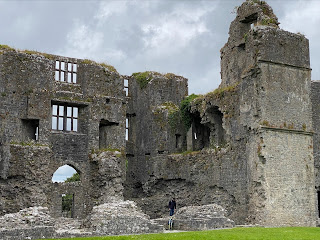A Vacation in Ruins
Ireland and Scotland are green. And moist (sorry if that word triggers you, but it’s true). And beautiful.
Our first night was in a hotel called Castle Kilronan, which
was more of a big manor house than a castle. Still an amazing place. It had to
be completely restored because the last family that lived there couldn’t afford
it, didn’t want to pay taxes on it, and so they removed the roof. If there’s no
roof, it’s not technically a building for tax purposes. But even lovely
restorations require maintenance. This was somewhere between Downton Abbey and
Miss Havisham’s dilapidated mansion. Beautiful old furnishings, lovely rooms,
fraying upholstery, stained carpet, cobwebs here and there. The attached spa
had different pools, half of which had features that didn’t work. Between Covid
losses of tourism and the same labor shortages we are experiencing at home,
it’s pretty hard to keep it all up!
Along the way, farms had new buildings built up next to the
crumbling stone barns and houses of the past. Empty castles and old churches dot
the landscape, any of which, if found in the U.S., would attract tourists,
restoration dollars, and national park rangers. Many of them are left to decay
in peace.
We visited Kylemore Abbey in Ireland, which includes a
gorgeous house, church, Victorian walled gardens, all in the stunning setting
of lakes and small mountains. It was built by a British man who married the
daughter of an extremely wealthy and generous American. The young couple built
an unbelievably grand estate and hired all the experts and used only the best
materials, and guess what? He eventually lost his fortune and the house began
to fall apart. A group of Benedictine nuns left Europe after their monastery
burned down in World War I, bought the Abbey and tried to restore it. It’s a
continuing process. They need new living quarters, but from the looks of it
that particular project has been stalled for some time.
We’ve been building monuments to ourselves since the Tower
of Babel, and probably before that. They leave some beautiful remains, intact
or not.
Today we toured Iona, an island that is a sacred spot for many Christians, dating back to the 7th century. George Macleod, founder of the Iona Community in 1938, said that Iona is “a thin place where only tissue paper separates the material from the spiritual.” I understand that feeling, though I don’t experience it myself in an ancient abbey. For me, I usually find the thin space out in God’s creation, where so much of what I see was created almost entirely for the Lord’s own delight. I also find it in certain communal events or even cityscapes that bring me joy. It’s a reminder that you and I, also, are his delight, the results of his joy and creativity.








